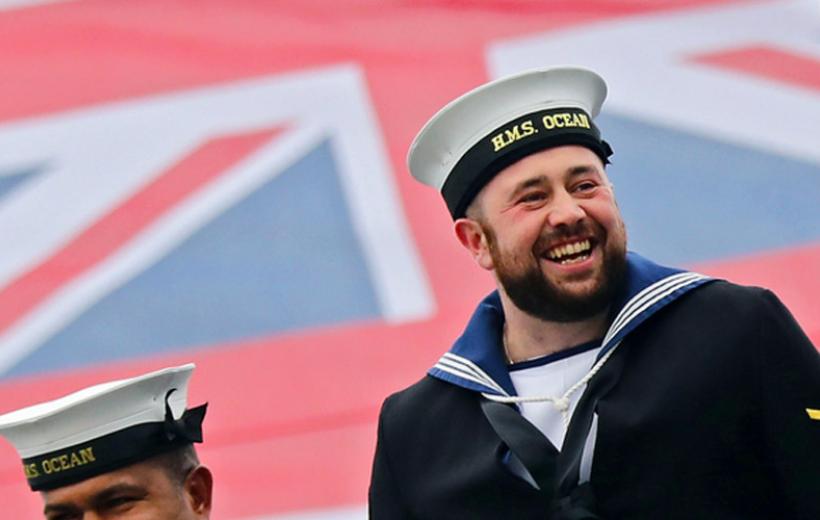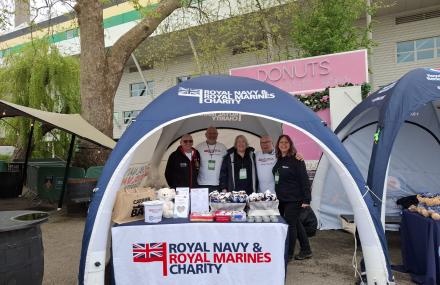The HMS Raleigh Passing Out Parade on the 8th of November 2024 was a memorable event, celebrating the achievements of 64 recruits who completed their initial training and now embark on their careers with the Royal Navy. Representing divisions Fisher and Cornwell, these recruits included individuals from diverse backgrounds across the Commonwealth, with representation from Ghana, Kenya, South Africa, and St. Vincent. Friends and family travelled not only from across the country but from all around the world to witness this proud moment, filling the parade grounds with an atmosphere of joy and admiration. For many families, it was a chance to see their loved ones’ dedication and resilience rewarded, making the occasion truly unforgettable for everyone in attendance.
The first HMS RALEIGH was funded and designed by
Sir Walter Raleigh himself in 1587. He lent the ship to
the Queen for the sum of £500 and she made it the
flagship of her navy, renaming it the Ark Royal.
The second RALEIGH was a captured American 5th
Rate of 697 tonnes, commissioned in 1778. It was
sold in 1783.
The third of the name was a 16 gun brig sloop that
saw action in the China Seas, built in 1806 by Hurry
and Howden Dock and serving until 1835 when she
foundered off Formosa in a typhoon.
The fourth RALEIGH was built at Chatham in 1845
and saw action in 1857 on the Canton River during
the Second China War, destroying 13 war junks and
Tungkun in 1857. She was wrecked on Raleigh Rock
off Macao, unfortunately.
Commissioned in 1873, the fifth HMS RALEIGH was
one of the last steam and sail powered ships in the
Royal Navy and the last to round Cape Horn under
canvas. She was decommissioned in 1905.
The sixth RALEIGH was a light cruiser of 9,750
tonnes, completed in 1919. She served with the
American West Indies station. Sadly she foundered
off Labrador in 1922.
The current HMS RALEIGH was commissioned in
1938 under the Military Training Act, new entries of
Ordinary Seamen were accepted at the rate of 300
per week.
Due to the Second World War, much of the training
was run by the Women’s Royal Naval Service or
WRNS. Initial training for Ordinary Seamen was then
an 11 week course involving Drill, Military Training,
Seamanship and plenty of Sport.
In 1944 US Naval forces took over the entire
Establishment, using it as an embarkation centre
for Operation Overlord. RALEIGH was returned to the
Royal Navy in July of that year.
Following the closure of DAUNTLESS, WRNS Phase
1 training was moved to RALEIGH in 1981 with the RN
Supply School moving in 1983. WRNS training was
eventually integrated with males in 1990. The School
of Seamanship arrived in 1991. The RN Submarine
School moved from DOLPHIN in Gosport in 2000 and
the Naval Military Training School transferred from
HMS CAMBRIDGE in 2001.
HMS RALEIGH is a unique and complex establishment
with many diverse and important tasks, running over
200 different courses per year with a throughput
of approximately 25,000 people. One of the future
safeguards of the future capability of the Royal
Navy is the determination to maintain the highest
standards of training at HMS RALEIGH.
Week 1 The recruits join HMS RALEIGH and,
after an extended period of consideration, sign
an employment contract with a requirement to
undergo 28 days’ training before being allowed
to leave voluntarily. They are introduced to the
Divisional Staff and start team building; the
recruits are encouraged to learn about each other,
their effect on their team (the class) and how to
work together to best advantage. They are also
introduced to Physical Education (PEd), including
the Naval Swimming Test; this has to be completed
satisfactorily before the recruits can Pass Out. The
recruits visit the Parade Ground where they learn
how to march as a class and other drill movements
such as standing to attention and saluting. At the
weekend they go to church, carry out kit (uniform)
maintenance and take part in a range of sports.
Week 2 The tempo starts to increase this week
with more PEd and drill. The principles of kit
maintenance are developed and the recruits take
part in Ceremonial Divisions for the first time. At
the weekend they go to church, work on maintaining
their kit, undertake some teamwork lessons and
have the opportunity to take part in more sporting
activities.
Week 3 A busy and active week with the recruits
developing their teamwork. The first exercise
‘Exercise Daring Leap’ is based on practical
teamwork at Pier Cellars, an old pilchard harbour in
South East Cornwall (now owned by HMS RALEIGH).
The recruits get involved in a number of team based
tasks including a 10 km hike and an assault course. The recruits are introduced to ceremonial weapons
drill in preparation for their Passing Out Parade.
Church, kit maintenance and further teamwork
lessons take place over the weekend.
Week 4 This week is mainly based on teaching
seamanship skills, with a wide syllabus covered
including: knots, berthing, working on ship’s
equipment and local experience on power boats. A
formal assessment is made, by the Divisional Staff,
of the recruits’ ability to maintain, prepare and store
kit. At the end of the week the 2.4 km run assessment
is assessed individually; this has to be completed
satisfactorily before the recruits can Pass Out. The aim of these weeks is to MARINISE the Recruit. Having attained basic military skills and
core values, the course moves into the maritime
environment developing basic skills and awareness
enabling the Recruit to be fit for professional trade
training and for their first ship.
Week 5 This week focuses on a maritime theme
with the recruits spending two days at Jupiter Point
(our Seamanship Centre). The recruits are taught
navigation, operational law and the capabilities of
the Royal Navy. On the physical side, the recruits
continue to build on their level of fitness with a
squad stretcher run. The weekend is a chance to
catch up with kit maintenance and revision for the
Naval General Training exam.
Week 6 - This week is predominantly devoted
to Naval Military Training where, under close
supervision, rifle handling tests and rifle firing
assessments, using the SA80 rifle, are undertaken
on firing ranges. The week is intense with Military
Training concluding on Saturday midday. Sunday
includes church, kit maintenance and preparations
for the first of three formal exercises, which take
place over the coming weeks.
Week 7 - This week the recruits are issued with their
No1 ceremonial uniform. Increased weapons drill leads
up to the selection of the Lead Guard for the Passing
Out Parade. The second exercise ‘Exercise Hidden
Dragon’ is conducted on Dartmoor, under supervision,
involving the recruits hiking and navigating across the
moor.
Week 8 - The first three days of this week are very busy
with first aid training, fire fighting and flood control.
Weapon drill intensifies in preparation for Passing Out
and the week finishes with the IMF pass out which
is the culmination of all the PEd. Over the weekend
the recruits make preparations for the final exercise
‘Audacious Defender’.
Week 9 - A busy and active week where the recruits
firstly complete the Obstacle Course, the week also
includes the final Naval General Training exam, which
must be passed prior to Passing Out. The final exercise
‘Audacious Defender’ brings together many aspects of
the Core Maritime Skills developed during the course.
Week 10 - The final week begins with a final kit and
accommodation inspection by CDR T. Wednesday
sees the Assault Course Competition between the
recruits. Wednesday evening is the course social
event in a function room within the establishment.
Final preparations are made for the Passing Out Parade
on Friday, which marks the successful completion of
Initial Royal Navy Training and the award of Royal Navy
epaulettes to the now most junior members of the
Royal Navy.
Cornwell Division is named after John “Jack”
Travers Cornwell. VC.
Cornwell, a Boy First Class Royal Navy, was born
on 8th January 1900 at Leyton, son of Eli and Alice
Cornwell.
At the outbreak or World War One his father joined
the Army, and Jack was given his chance to join
the Navy. He went through basic training at
Devonport from 27th July 1915 and became a First
Class Boy on HMS Chester for active service in
Admiral Beatty’s North Sea Squadron.
A few months after joining the squadron they came
to grips with the German High Sea’s Fleet near
Jutland on 31st May 1916; Where the ship came
under heavy fire from German Cruisers.
Four enemy shells struck the Chester near to
Jack’s weapon position killing the other members
of his gun crew. Despite receiving multiple
shrapnel and splinter wounds Jack remained at
his position awaiting orders until Chester retired
from the action and made for Immingham for
emergency repairs.
Upon reaching port Jack was transferred to
Grimsby hospital where he died of his wounds two
days later. He was posthumously awarded the
Victoria Cross.
Admiral of the Fleet John Arbuthnot “Jacky” Fisher,
1st Baron Fisher of Kilverstone, GCB, OM, GCVO (25
January 1841 – 10 July 1920).
Admiral of the Fleet Fisher was known for his efforts
at naval reform. He had a huge influence on the
Royal Navy in a career spanning more than 60 years,
starting in a navy of wooden sailing ships armed
with muzzle-loading cannon and ending in one of
steel-hulled battle cruisers, submarines and the
first aircraft carriers. The argumentative, energetic,
reform-minded Fisher is often considered the
second most important figure in British naval
history, after Lord Nelson.
Fisher is primarily celebrated as an innovator,
strategist and developer of the navy rather than a
seagoing admiral involved in major battles, although
in his career he experienced all these things. When
appointed First Sea Lord he removed 150 ships then
on active service but which were no longer useful
and set about constructing modern replacements,
creating a modern fleet prepared to meet Germany
during World War I.
Fisher saw the need to improve the range, accuracy
and firing rate of naval gunnery, and was an early
proponent of the use of the torpedo, which he
believed would supersede big guns for use against
ships. As Controller, he introduced torpedo boat
destroyers as a class of ship intended for defence
against attack from torpedo boats or submarines.
As First Sea Lord, he was responsible for the
construction of HMS DREADNOUGHT, the first
all big gun battleship, but he also believed that
submarines would become increasingly important
and urged their development. He was involved
with the introduction of turbine engines to replace
reciprocating designs, and the introduction of oil
fuelling to replace coal. He introduced daily baked
bread on board ships, whereas when he entered
the service it was customary to eat hard biscuits,
frequently infested by weevils.
Head Helicopters 1
Commanding Officer Captain R J Roe ADC, Royal Navy
Commanding Officer HMS Raleigh
Parade Commander Commander M McCallum, Royal Navy
Initial Naval Training
Commander Training Commander A Tipping, Royal Navy
Officer Commanding Initial Naval Training Lieutenant Commander G Tomlinson, Royal Navy
Staff Officer Initial Naval Training Lieutenant Commander J Stark, Royal Navy
Initial Naval Training Executive Warrant Officer Warrant Officer First Class I Bailey, Royal Navy
Cornwell Divisional Training Staff
Divisional Training Officer Lieutenant J Lawrence, Royal Navy
Assistant Divisional Training Officer Chief Petty Officer P Gibbs, Royal Navy
Divisional Instructor (STBD) Petty Officer S Fidock, Royal Navy
Divisional Leading Hand Leading Hand D Crawshaw, Royal Navy
Fisher Divisional Training Staff
Divisional Training Officer Warrant Officer First Class D Merridue, Royal
Navy
Assistant Divisional Training Officer Chief Petty Officer S Romang, Royal Navy
Divisional Instructor (STBD) Petty Officer O Thomas, Royal Navy
Divisional Leading Hand Leading Hand M Hallowes, Royal Navy
Physical Trainer Leading Hand Physical Trainer H Hayes,
Royal Navy
Band HM Royal Marine Band, Plymouth
Band Master Warrant Officer Second Class L Keachie,
Royal Marines
Royal Naval Association Veterans Mr C Ball
Mr T Whitty
Cornwell Division
1. Divisional Instructor PO Fidock
2. LOGS(CS) King
3. RNP Howeth
4. ETME(SM) Bondars
5. LOGS(CS) Bennett
6. LOGS(SC) Cain
7. AA(WE) Jarvis
8. ET(CIS) Pena-Childs
9. WS(AWT) Bell
10 LOGS(SC) Free
11. MA Brown
12 WS(AWT) Smith.
13. WS(AWT) Button
14. WS(SSM) Holmes
15. SEA Harris
16. WS(SSM) Conran
17. AA(WE) Moore
18. WS(AWT) Turner
19. ETME Exonsmith
20. ET(CIS) NcNeil
21. ETWE Fox
22. AA(ME) Caine
23. AET Humphries
24. AET Orchard
25. NA(AH) Horsley
26. RNR Shelswell
27. AA(SM) Pascoe
28. LOGS(CS) Luscombe
29. ETWE Thomas
30. ETME Kirk
31. WS(AWT) Charlton Cross
32. -
33. AET Gale
Fisher Division
1. Divisional Instructor PO Thomas
2. AA(CIS) Edgell
3. SET Chambers
4. ETWE(SM) Hardy
5. LOGS(SC) Mohammed
6. LOGS(CS) Marlow
7. SEA Robinson
8. SEA Kennedy
9. ETME Faiers
10. ETWE Turner
11. AET Nuttall
12. WS(AWT) Williams
13. NA(ACMN) Gedye
14. MA Douglas
15. ETWE Warburton
16. AET Calow
17. AET Francis
18. ETWE Clift-Bowmar
19. AET Shaw
20. LOGS(SC) Asamoah
21. ETWE(SM) Partington
22. NA(AH) Warsop
23. LOGS(CS) Wangui
24. ETME Westfield
25. AA(SM) Burgess
26. WS(AWT) Marsh
27. NA(AH) Flannagan-Gabriel
28. ETWE(SM) Depledge
29. AA(CIS) Johnstone
30. ETME Hargreaves
31. AA(SM) Cookson
32. AET Atkinson
33. ETWE(SM) Brown
34. -
35. AA(WE) Priestly










